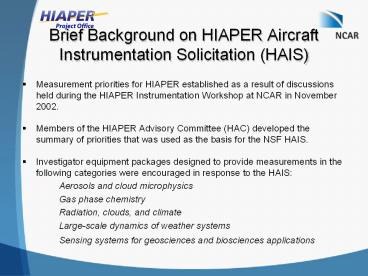Brief Background on HIAPER Aircraft Instrumentation Solicitation (HAIS) - PowerPoint PPT Presentation
1 / 6
Title:
Brief Background on HIAPER Aircraft Instrumentation Solicitation (HAIS)
Description:
Brief Background on HIAPER Aircraft Instrumentation Solicitation (HAIS) ... the GV platform smaller payload capability, limited cabin space and available ... – PowerPoint PPT presentation
Number of Views:88
Avg rating:3.0/5.0
Title: Brief Background on HIAPER Aircraft Instrumentation Solicitation (HAIS)
1
Brief Background on HIAPER Aircraft
Instrumentation Solicitation (HAIS)
- Measurement priorities for HIAPER established as
a result of discussions held during the HIAPER
Instrumentation Workshop at NCAR in November
2002. - Members of the HIAPER Advisory Committee (HAC)
developed the summary of priorities that was used
as the basis for the NSF HAIS. - Investigator equipment packages designed to
provide measurements in the following categories
were encouraged in response to the HAIS - Aerosols and cloud microphysics
- Gas phase chemistry
- Radiation, clouds, and climate
- Large-scale dynamics of weather systems
- Sensing systems for geosciences and biosciences
applications
2
Sensor Categorization
- Categorization dictated by the ease with which a
given instrument can be integrated onto the GV
and the level of effort that will be required for
ongoing sensor maintenance and support. - Standard use Likely to be called on for most
missions and will not require extensive
modification or RD effort to implement.
Following completion and delivery, such sensors
will be maintained and operated by NCAR/Earth
Observing Laboratory (EOL) staff. - Routine operational Technologies that can be
readily adapted to HIAPER following a relatively
short RD effort, after which the developed
sensor can be transitioned to NCAR for
maintenance and operation perhaps as a Standard
instrument. During development, deployment of
this type of instrument may require additional
support personnel and funds and possibly
additional expertise in the processing, analysis,
and release of data. These sensors to be made
available upon request. Could be operated and
maintained by NCAR personnel, with some level of
involvement by the originating PI. - Research Developing technologies that require
a continued RD effort. Such sensors will
require extensive PI involvement in the
development and evaluation and will likely not
be turned over to NCAR for routine operations
for several years after the start of the
development effort. Continued involvement of
the PI or research group likely to be required
for particular mission deployments and during
data interpretation and analysis.
Essential for NCAR and NSF to understand the
category intended for each of the HAIS awarded
developments in order to begin assessing
requirements (personnel and financial) for
ongoing support of the instruments following
completion and delivery.
3
Designing the Next Generation of Airborne
Instrumentation Goals and Requirements
The characteristics of the GV platform smaller
payload capability, limited cabin space and
available power require that members of the
scientific community adopt new approaches to
instrumentation design. Consider
GV NSF/NCAR C-130
Cabin Length 50.1 ft (15.3 m) 40.4 ft (12.3 m)
Cabin Height 6.2 ft (1.9 m) 9.0 ft (2.7 m)
Cabin Width 7.3 ft (2.2 m) 10.0 ft (3.0 m)
Max. Scientific Payload 7,900 lbs (3,583 kg) 13,000 lbs (5,897 kg)
Desired GV Sensor Attributes Small Light weight Low power Autonomous Meet FAA/RAF design requirements Intelligent and communicative Robust Simple to install Multi-platform compatible Fast operation characteristics (higher sampling rates related to increased dynamic effects)
4
Additional Notes
- As outlined in the NSF HAIS, instruments
developed using the 12.5M of HIAPER funding are
to become part of the communitys core of pool
and shared instruments. - Instruments will, in the majority of cases, be
required to reside at NCAR, and each instrument
will carry a NSF property tag. - Developers required to adhere to instrumentation
design and construction requirements as called
out in the NSF/NCAR GV Investigators Handbook.
5
Contracting
- Responsibility for making and administering
awards transferred to UCAR by NSF - MREFC guidelines must be followed during the
award and development of instruments using this
12.5M - Therefore
- Milestone payments established to monitor
progress - Deliverables (to accompany the instrument) to
include - Sensor operation, integration, and calibration
info. - Data processing algorithms and software
- Reporting requirements
- Acceptance criteria
6
Contracting, contd
- Role of Technical Representatives (TRs)
- Role of Contract Administrators (CAs)
- Questions for Operations Maintenance
- Testing
- Warranty
- Negotiations































